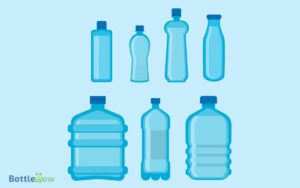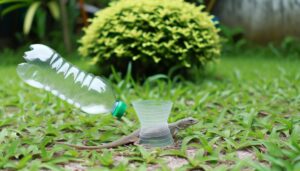Brita Water Bottle Hard to Drink Out of: A Guide
Your Brita water bottle might be hard to drink from due to its rigid construction, which limits water flow and requires more effort to squeeze. Misaligned lids and gaskets can cause leaks, and improper straw alignment often affects suction.
Cleaning the mouthpiece, straw, and filter regularly can help, as debris buildup can obstruct flow. Check for cracks and verify components are correctly seated for peak performance.
If you’re still struggling, newer models and alternative brands could provide a better experience. Explore further tips and solutions to enhance your hydration experience.
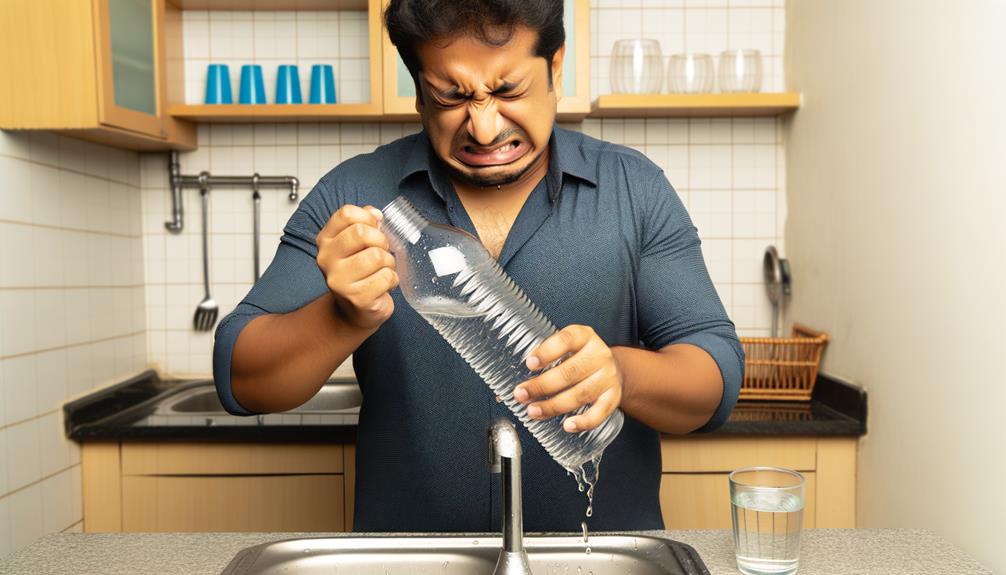
Key Takeaways
- Check the Lid Alignment: Misaligned lids can cause leaks and affect the drinking experience.
- Inspect and Clean the Straw: Poor suction may result from debris buildup or improper straw alignment.
- Address Limited Water Flow: Rigid bottle material and narrow nozzle can restrict water flow.
- Ensure Proper Filter Seating: Misaligned filters can obstruct water flow; regular inspection is essential.
Brita Water Bottle Hard to Drink From – Causes and Solutions
| Issue | Description | Solution |
|---|---|---|
| Clogged Filter | A clogged filter can reduce water flow, making it harder to drink. | Replace the filter with a new one and ensure it’s properly installed. |
| Filter Not Primed | New filters may need to be primed before use. | Soak the filter in water for 15 minutes to remove air bubbles. |
| Air Pressure Issue | Lack of airflow can create suction problems when drinking. | Ensure the air valve is clear or open the lid slightly to allow airflow. |
| Bottle Overfilled | Overfilling can prevent proper water flow through the spout. | Fill the bottle to the recommended level for optimal flow. |
| Mouthpiece Blocked | Dirt or debris can block the mouthpiece, making it difficult to sip. | Clean the mouthpiece thoroughly to remove any blockages. |
| Tight Lid | If the lid is screwed on too tightly, it can affect water flow. | Loosen the lid slightly to improve water flow when drinking. |
| Filter Placement | Improper filter placement can obstruct water movement. | Reinstall the filter properly to ensure smooth water flow. |
Common Design Flaws
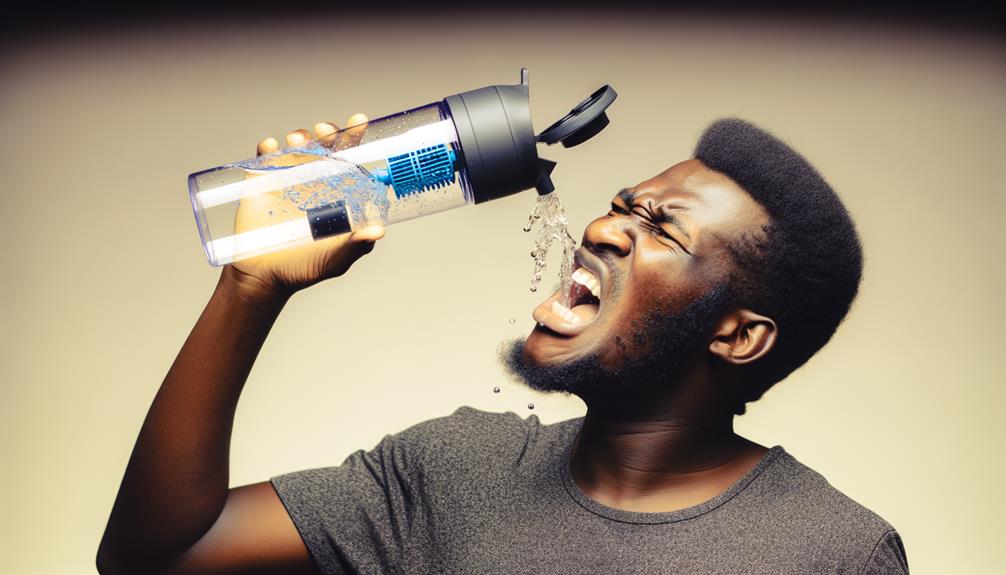
One common design flaw in Brita water bottles is the tendency for the lids to leak, even when securely tightened. You might notice small drips or larger spills, which can be frustrating and inconvenient.
This issue often stems from the silicone gasket inside the lid not sealing properly. It’s important to inspect this gasket regularly for wear or debris that could compromise its function.
Also, verify that the lid is aligned correctly before tightening. If the problem persists, consider reaching out to Brita’s customer service for a replacement.
Understanding this flaw helps you maintain a cleaner, more efficient hydration experience. By being proactive, you can mitigate some of the common issues associated with these water bottles.
Difficult-to-Squeeze Bottles
You might find the Brita water bottle difficult to squeeze due to its stiff bottle material.
This rigidity can limit water flow, making it challenging to drink efficiently.
Addressing these issues could greatly improve your user experience.
Stiff Bottle Material
Many users find the stiff material of Brita water bottles challenging to squeeze, which can hinder proper water flow and overall usability.
When you use these bottles, the rigid construction requires more effort to generate sufficient pressure, making it difficult to get a steady stream of water. This can be particularly problematic during physical activities where quick hydration is essential.
The design choice of using stiffer plastic likely aims for durability, but it inadvertently impacts the user experience. If you’re accustomed to softer, more pliable bottles, you might find this a frustrating adjustment.
To mitigate this, consider combining firm pressure with a more deliberate grip to optimize water flow. However, the inherent stiffness remains a key limitation for many users.
Limited Water Flow
Several users report that the limited water flow in Brita water bottles stems from their difficult-to-squeeze design.
When you try to drink, the rigid structure requires more effort to compress, reducing the ease of water flow. This design flaw can be particularly frustrating if you’re physically exerted or need quick hydration.
The bottle’s narrow nozzle adds to the problem, creating further resistance. To alleviate this, consider checking the bottle’s vent mechanism; sometimes adjusting it can improve flow.
Additionally, regular cleaning guarantees no obstructions affect performance.
While Brita bottles offer excellent filtration, understanding these mechanical limitations can help you use them more effectively and avoid unnecessary strain.
Troublesome Straw Issues
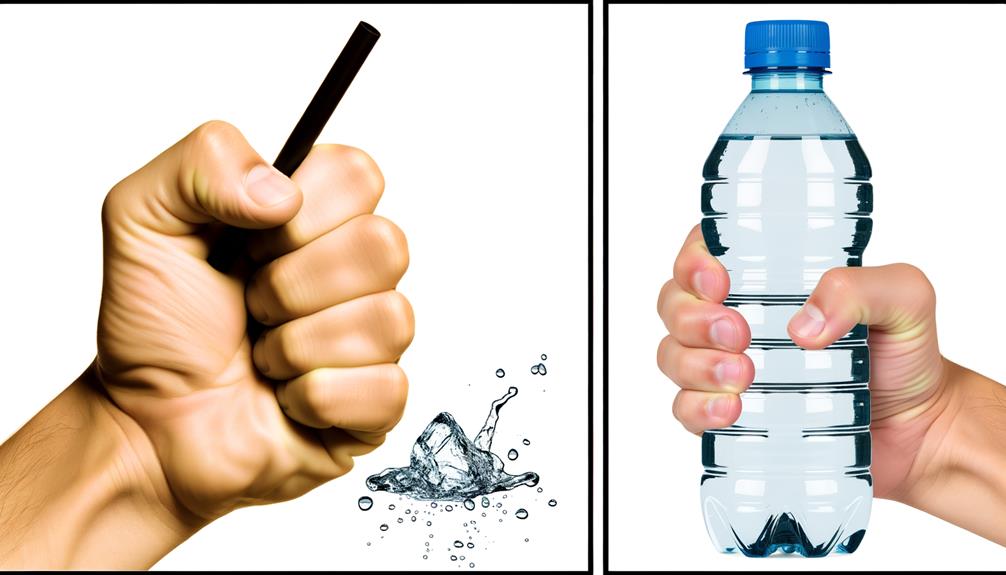
Users frequently encounter problems with the Brita water bottle’s straw, such as poor suction and blockages. These issues often stem from improper alignment or debris buildup within the straw mechanism.
When the straw isn’t correctly seated, it disrupts the vacuum needed for proper water flow, making it hard to drink. Additionally, small particles can clog the straw, further impeding suction.
To resolve these issues, verify the straw is firmly connected and clean it regularly by detaching it from the bottle and rinsing thoroughly. If blockages persist, inspect for any damage that might necessitate replacement.
Cap and Mouthpiece Troubles
When dealing with Brita water bottle issues, cap and mouthpiece troubles are often a significant concern due to leaks and improper sealing.
You might notice water seeping out, which typically results from a misaligned or damaged cap. To address this, confirm the cap is tightly screwed on and inspect for any cracks or wear.
Sometimes, the mouthpiece can also be problematic if it’s not securely attached or has debris obstructing it. Regularly clean the mouthpiece with warm, soapy water to prevent buildup.
If the mouthpiece seems loose, check the rubber gasket for wear and replace it if necessary. These simple steps can enhance your bottle’s performance, confirming a leak-free, smoother drinking experience.
Airflow Problems
You’ll notice that airflow issues in your Brita water bottle can severely affect your drinking experience.
Limited air ventilation often leads to suction difficulty, making it hard to get a steady flow of water.
This problem frequently stems from valve design issues that restrict proper airflow.
Limited Air Ventilation
A common issue with Brita water bottles is their limited air ventilation, which can hinder efficient water flow and make drinking difficult. The design often restricts airflow, creating a vacuum effect that requires more effort to draw water. This problem can be analyzed through the following aspects:
| Aspect | Problem | Impact |
|---|---|---|
| Air Vent Size | Small vent holes | Insufficient airflow |
| Vent Placement | Poorly positioned near mouthpiece | Inefficient pressure balance |
| Vent Cleanliness | Potential clogging from water impurities | Reduced vent effectiveness |
Understanding these elements can help you diagnose why your Brita bottle might be hard to drink from. Ensuring the vent is clean and unobstructed, and recognizing the limitations of its design, can mitigate some of these issues.
Suction Difficulty Encountered
Many users encounter significant suction difficulty with Brita water bottles due to inadequate airflow, which often results in a frustrating drinking experience.
When you try to take a sip, the bottle’s design doesn’t allow sufficient air to flow back into the bottle, creating a vacuum effect. This lack of airflow means you have to exert more effort to draw water out, making hydration cumbersome.
The restricted airflow can stem from the bottle’s filter system or the design of the drinking spout. To address this, you might need to experiment with adjusting the bottle’s components or look for alternative solutions to improve the airflow.
Understanding this issue helps you make informed decisions about optimizing your drinking experience with Brita bottles.
Valve Design Issues
Understanding the valve design issues in Brita water bottles reveals how airflow problems can considerably impair the drinking experience. The valve is supposed to regulate the flow of water and air, ensuring a smooth sip.
However, when the valve design isn’t optimized, it can restrict airflow, creating a vacuum effect. This makes it harder for you to draw water with each sip. Additionally, insufficient air passage can cause the bottle to collapse inward, further complicating the effort needed to drink.
These design flaws often result in an inconsistent flow, making the process frustrating. Addressing these airflow issues would require a redesign of the valve to facilitate better air circulation, ultimately enhancing your overall user experience.
User Tips and Tricks
Maximize the performance of your Brita water bottle by regularly cleaning the filter and bottle components.
Disassemble the bottle and gently scrub the mouthpiece, straw, and cap using mild dish soap and warm water. Rinse thoroughly to remove any soap residue.
Ensure the filter is correctly seated by aligning it with the designated grooves. If you notice a decreased water flow, soak the filter in cold water for 15 minutes to flush out air bubbles.
When reassembling, make sure all components are securely tightened to prevent leaks.
For ideal hydration, avoid overfilling the bottle, which can create suction issues.
Alternative Solutions
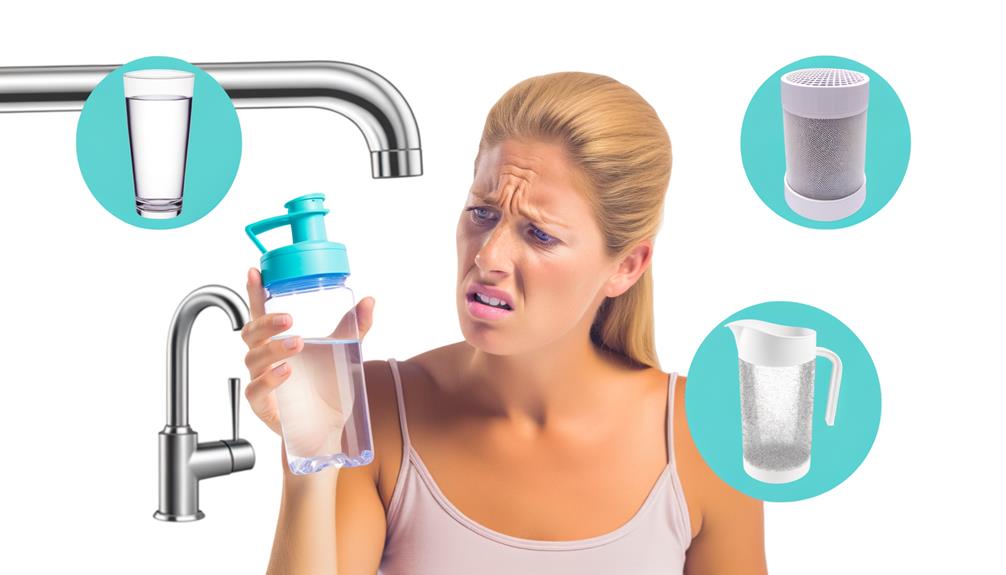
If regular maintenance doesn’t resolve the issues, consider exploring these alternative solutions to enhance your Brita water bottle’s performance.
First, check the alignment of the filter and cap. Misalignment can obstruct water flow. Make sure the filter is correctly seated in its slot.
Next, inspect the mouthpiece for any blockages or damage. Replace it if necessary to guarantee a smooth water flow.
Additionally, try using a different filter type; some users find that Brita’s Longlast filters offer improved performance.
Finally, consider upgrading to a newer Brita model with enhanced design features aimed at resolving common drinking issues.
Conclusion
You’ve encountered frustrating design flaws with your Brita water bottle, from difficult squeezing and troublesome straws to cap and airflow issues. These issues make it challenging to stay hydrated on the go, forcing you to consider other filtration options. A Lifestraw vs Brita comparison might help you determine if an alternative bottle offers better ease of use and reliability. Finding the right water bottle ensures you get clean water without unnecessary hassle.
Instead of battling these problems, consider user tips like regular maintenance and part adjustments.
Alternatively, explore other brands that prioritize ease of use and functionality.
By weighing your options, you can guarantee a more satisfying hydration experience, whether you stick with Brita or switch to a more user-friendly alternative.

